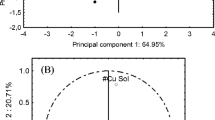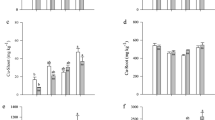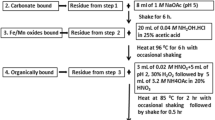Abstract
This study sought to evaluate the potential of perennial peanut (Arachis pintoi) for copper phytoremediation in vineyard soils (Inceptisol and Mollisol) contaminated with copper and copper mining waste. Our results showed high phytomass production of perennial peanut in both vineyard soils. Macronutrient uptakes were not negatively affected by perennial peanut cultivated in all contaminated soils. Plants cultivated in Mollisol showed high copper concentrations in the roots and shoots of 475 and 52 mg kg−1, respectively. Perennial peanut plants showed low translocation factor values for Cu, although these plants showed high bioaccumulation factor (BCF) for both vineyard soils, Inceptisol and Mollisol, with BCF values of 3.83 and 3.24, respectively, being characterized as a copper hyperaccumulator plant in these soils. Copper phytoextraction from Inceptisol soil was the highest for both roots and entire plant biomass, with more than 800 mg kg−1 of copper in whole plant. The highest potential copper phytoextraction by perennial peanut was in Inceptisol soil with copper removal of 2,500 g ha−1. Also, perennial peanut showed high potential for copper phytoremoval in copper mining waste and Mollisol with 1,700 and 1,500 g of copper per hectare, respectively. In addition, perennial peanuts characterized high potential for phytoextraction and phytostabilization of copper in vineyard soils and copper mining waste.



Similar content being viewed by others
References
Peruch LAM, Bruna ED (2008) Relação entre doses de calda bordalesa e de fosfito potássico na intensidade do míldio e na produtividade da videira cv. ‘Goethe’. Ciênc Rural 38:2413–2418
Laybauer L (1998) Incremento de metais pesados na drenagem receptora de efluentes de mineração—Minas do Camaquã, Sul do Brasil. Rev Bras Rec Hídric 3:29–36
McCutcheon SC, Schnoor JL (2003) Phytoremediation: transformation and control of contaminants (ed). Hoboken, NJ, Wiley
Pulford ID, Riddell-Black D, Stewart C (2002) Heavy metal uptake by willow clones from sewage sludge-treated soil: the potential for phytoremediation. Int J Phytoremediat 4:59–72
Jiang LY, Yang XE, He ZL (2004) Growth response and phytoextraction of cooper at different levels in soils by Elsholtzia splendens. Chemosphere 55:1179–1187
Chen WN, Wu CH, James EK et al (2008) Metal biosorption capability of Cupriavidus taiwanensis and its effects on heavy metal removal by nodulated Mimosa pudica. J Hazard Mater 151:364–371
Chen YX, Wang YP, Wu WX et al (2006) Impacts of chelate-assisted phytoremediation on microbial community composition in the rhizosphere of a copper accumulator and non-accumulator. Sci Total Environ 356:247–255
Chen YX, Wang YP, Lin Q et al (2005) Effect of copper-tolerant rhizosphere bacteria on mobility of copper in soil and copper accumulation by Elsholtzia splendens. Environ Int 31:861–866
Ke W, Xiong ZT, Chen S et al (2007) Effects of copper and mineral nutrition on growth, copper accumulation and mineral element uptake in two Rumex japonicus populations from a copper mine and an uncontaminated field sites. Environ Exp Bot 59:59–67
Sheng XF, Xia JJ, Jiang CY (2008) Characterization of heavy metal-resistant endophytic bacteria from rape (Brassica napus) roots and their potential in promoting the growth and lead accumulation of rape. Environ Pollut 156:1164–1170
Wang H, Jia Y (2009) Bioaccumulation of heavy metals by Phragmites australis cultivated in synthesized substrates. J Environ Sci 21:1409–1414
Wang FA, Lin XG, Yin R (2007) Role of microbial inoculation and chitosan in phytoextraction of Cu, Zn, Pb and Cd by Elsholtzia splendens—a field case. Environ Pollut 147:248–255
Bhatti HN, Khalid R, Hanif MA (2009) Dynamic biosorption of Zn(II) and Cu(II) using pretreated Rosa gruss an teplitz (red rose) distillation sludge. Chem Eng J 148:434–443
Ma Y, Rajkumar M, Freitas H (2009) Inoculation of plant growth promoting bacterium Achromobacter xylosoxidans strain Ax10 for the improvement of copper phytoextraction by Brassica juncea. J Environ Manage 90:831–837
Ma Y, Rajkumar M, Freitas H (2009) Isolation and characterization of Ni mobilizing PGPB from serpentine soils and their potential in promoting plant growth and Ni accumulation by Brassica spp. Chemosphere 75:719–725
Ma Y, Rajkumar M, Freitas H (2009) Improvement of plant growth and nickel uptake by nickel resistant-plant-growth promoting bacteria. J Hazard Mater 166:1154–1161
Alvarenga P, Gonçalves AP, Fernandes RM et al (2009) Organic residues as immobilizing agents in aided phytostabilization: (I) Effects on soil chemical characteristics. Chemosphere 74:1292–1300
Grandlic CJ, Palmer MW, Maier RM (2009) Optimization of plant growth-promoting bacteria-assisted phytostabilization of mine tailings. Soil Biol Biochem 41:1734–1740
Ruttens A, Mench M, Colpaert JV et al (2006) Phytostabilization of a metal contaminated sandy soil. I: Influence of compost and/or inorganic metal immobilizing soil amendments on phytotoxicity and plant availability of metals. Environ Pollut 144:524–532
Domínguez MT, Madrid F, Marañón T et al (2009) Cadmium availability in soil and retention in oak roots: potential for phytostabilization. Chemosphere 76:480–486
Perin A, Guerra JGM, Teixeira MG (2003) Cobertura do solo e acumulação de nutrientes pelo amendoim forrageiro. Pesq Agropec Bras 38:791–796
Posada SL, Mejia JA, Noguera R et al (2006) Evaluación productiva y análisis microeconómico del maní forrajero perenne (Arachis pintoi) en un sistema de levante-ceba de porcinos en confinamiento. Rev Col Cienc Pec 19:259–269
Hohnwald S, Rischkowsky B, Camarão AP et al (2006) Integrating cattle into the slash-and-burn cyclo on smallholdings in the Eastern Amazon, using grass-capoeira or grass-legume. Agric Ecosyst Environ 117:266–276
Matos ES, Mendonça ES, Lima PC et al (2008) Green manure in coffee systems in the region of zona da mata, minas gerais: characteristics and kinetics of carbon and nitrogen mineralization. Rev Bras Ci Solo 32:2027–2035
Khetmalas MB, Bal AK (2005) Microscopical studies of Arachis pintoi root nodule with special reference to bacteroids and oleosomes at different stages of plant growth and nodule development. Plant Sci 168:557–563
Andreazza R, Okeke BC, Lambais MR et al (2010) Bacterial stimulation of copper phytoaccumulation by bioaugmentation with rhizosphere bacteria. Chemosphere 81:1149–1154
Schouwvenberg VJCH, Walinge I (1973) Methods of analysis for plant material. (ed.) Agriculture University, Wageningen
Yoon J, Cao X, Zhou Q (2006) Accumulation of Pb, Cu, and Zn in native plants growing on a contaminated Florida site. Sci Total Environ 368:456–464
Shi G, Cai Q (2009) Cadmium tolerance and accumulation in eight potential energy crops. Biotechnol Adv 27:555–561
Monni S, Selemaa M, White C et al (2000) Copper resistance of Calluna vulgaris originating from the pollution gradient of a Cu–Ni smelter, in southwest Finland. Environ Pollut 109:211–219
Rashed MN (2010) Monitoring of contaminated toxic and heavy metals, from mine tailings through age accumulation, in soil and some wild plants at Southeast Egypt. J Hazard Mater 178:739–746
Cluis C (2004) Junk–greedy greens: phytoremediation as a new option for soil decontamination. Biotech J 2:60–67
Meers E, Ruttens A, Hopgood M et al (2005) Potential of Brassic rapa, Cannabis sativa, Helianthus annuus and Zea mays for phytoextraction of heavy metals from calcareous dredged sediment derived soils. Chemosphere 61:561–572
Nicholson FA, Chambersa BJ, Williamsb JR et al (1999) Heavy metal contents of livestock feeds and animal manures in England and Wales. Bioresour Technol 70:23–31
Puschenreiter M, Horak O, Friesl W (2005) Low-cost agricultural measures to reduce heavy metal transfer into the food chain—a review. Plant Soil Environ 51:1–11
Acknowledgments
This project was supported by Coordenação de Aperfeiçoamento de Pessoal de Nível Superior (CAPES) and Conselho Nacional de Desenvolvimento Científico e Tecnológico (CNPq), Brazil.
Author information
Authors and Affiliations
Corresponding author
Rights and permissions
About this article
Cite this article
Andreazza, R., Bortolon, L., Pieniz, S. et al. Potential Phytoextraction and Phytostabilization of Perennial Peanut on Copper-Contaminated Vineyard Soils and Copper Mining Waste. Biol Trace Elem Res 143, 1729–1739 (2011). https://doi.org/10.1007/s12011-011-8979-z
Received:
Accepted:
Published:
Issue Date:
DOI: https://doi.org/10.1007/s12011-011-8979-z




